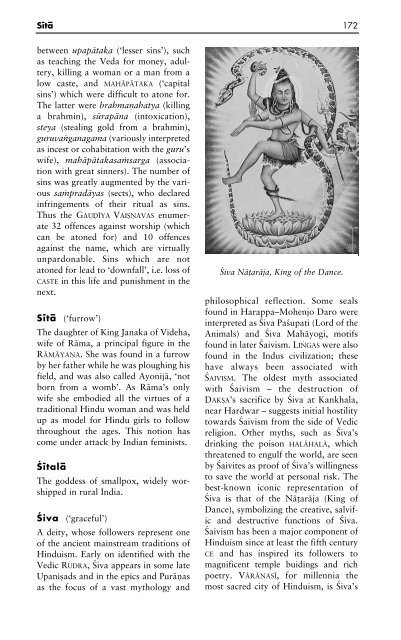A Concise Encyclopedia of Hinduism Klaus K Klostermaie
You also want an ePaper? Increase the reach of your titles
YUMPU automatically turns print PDFs into web optimized ePapers that Google loves.
Sïtä 172<br />
between upapätaka (‘lesser sins’), such<br />
as teaching the Veda for money, adultery,<br />
killing a woman or a man from a<br />
low caste, and MAHÄPÄTAKA (‘capital<br />
sins’) which were difficult to atone for.<br />
The latter were brahmaæahatya (killing<br />
a brahmin), sürapäna (intoxication),<br />
steya (stealing gold from a brahmin),<br />
guruvaöganagama (variously interpreted<br />
as incest or cohabitation with the guru’s<br />
wife), mahäpätakasaƒsarga (association<br />
with great sinners). The number <strong>of</strong><br />
sins was greatly augmented by the various<br />
saƒpradäyas (sects), who declared<br />
infringements <strong>of</strong> their ritual as sins.<br />
Thus the GAU¥ÏYA VAIÆŒAVAS enumerate<br />
32 <strong>of</strong>fences against worship (which<br />
can be atoned for) and 10 <strong>of</strong>fences<br />
against the name, which are virtually<br />
unpardonable. Sins which are not<br />
atoned for lead to ‘downfall’, i.e. loss <strong>of</strong><br />
CASTE in this life and punishment in the<br />
next.<br />
Sïtä (‘furrow’)<br />
The daughter <strong>of</strong> King Janaka <strong>of</strong> Videha,<br />
wife <strong>of</strong> Räma, a principal figure in the<br />
RÄMÄYAŒA. She was found in a furrow<br />
by her father while he was ploughing his<br />
field, and was also called Ayonijä, ‘not<br />
born from a womb’. As Räma’s only<br />
wife she embodied all the virtues <strong>of</strong> a<br />
traditional Hindu woman and was held<br />
up as model for Hindu girls to follow<br />
throughout the ages. This notion has<br />
come under attack by Indian feminists.<br />
Ÿïtalä<br />
The goddess <strong>of</strong> smallpox, widely worshipped<br />
in rural India.<br />
Ÿiva (‘graceful’)<br />
A deity, whose followers represent one<br />
<strong>of</strong> the ancient mainstream traditions <strong>of</strong><br />
<strong>Hinduism</strong>. Early on identified with the<br />
Vedic RUDRA, Ÿiva appears in some late<br />
Upani•ads and in the epics and Puräæas<br />
as the focus <strong>of</strong> a vast mythology and<br />
Ÿiva Näflaräja, King <strong>of</strong> the Dance.<br />
philosophical reflection. Some seals<br />
found in Harappa–Mohenjo Daro were<br />
interpreted as Ÿiva Paÿupati (Lord <strong>of</strong> the<br />
Animals) and Ÿiva Mahäyogi, motifs<br />
found in later Ÿaivism. LI¢GAS were also<br />
found in the Indus civilization; these<br />
have always been associated with<br />
ŸAIVISM. The oldest myth associated<br />
with Ÿaivism – the destruction <strong>of</strong><br />
DAKÆA’s sacrifice by Ÿiva at Kankhala,<br />
near Hardwar – suggests initial hostility<br />
towards Ÿaivism from the side <strong>of</strong> Vedic<br />
religion. Other myths, such as Ÿiva’s<br />
drinking the poison HALÄHALÄ, which<br />
threatened to engulf the world, are seen<br />
by Ÿaivites as pro<strong>of</strong> <strong>of</strong> Ÿiva’s willingness<br />
to save the world at personal risk. The<br />
best-known iconic representation <strong>of</strong><br />
Ÿiva is that <strong>of</strong> the Näflaräja (King <strong>of</strong><br />
Dance), symbolizing the creative, salvific<br />
and destructive functions <strong>of</strong> Ÿiva.<br />
Ÿaivism has been a major component <strong>of</strong><br />
<strong>Hinduism</strong> since at least the fifth century<br />
CE and has inspired its followers to<br />
magnificent temple buidings and rich<br />
poetry. VÄRÄŒASÏ, for millennia the<br />
most sacred city <strong>of</strong> <strong>Hinduism</strong>, is Ÿiva’s


















